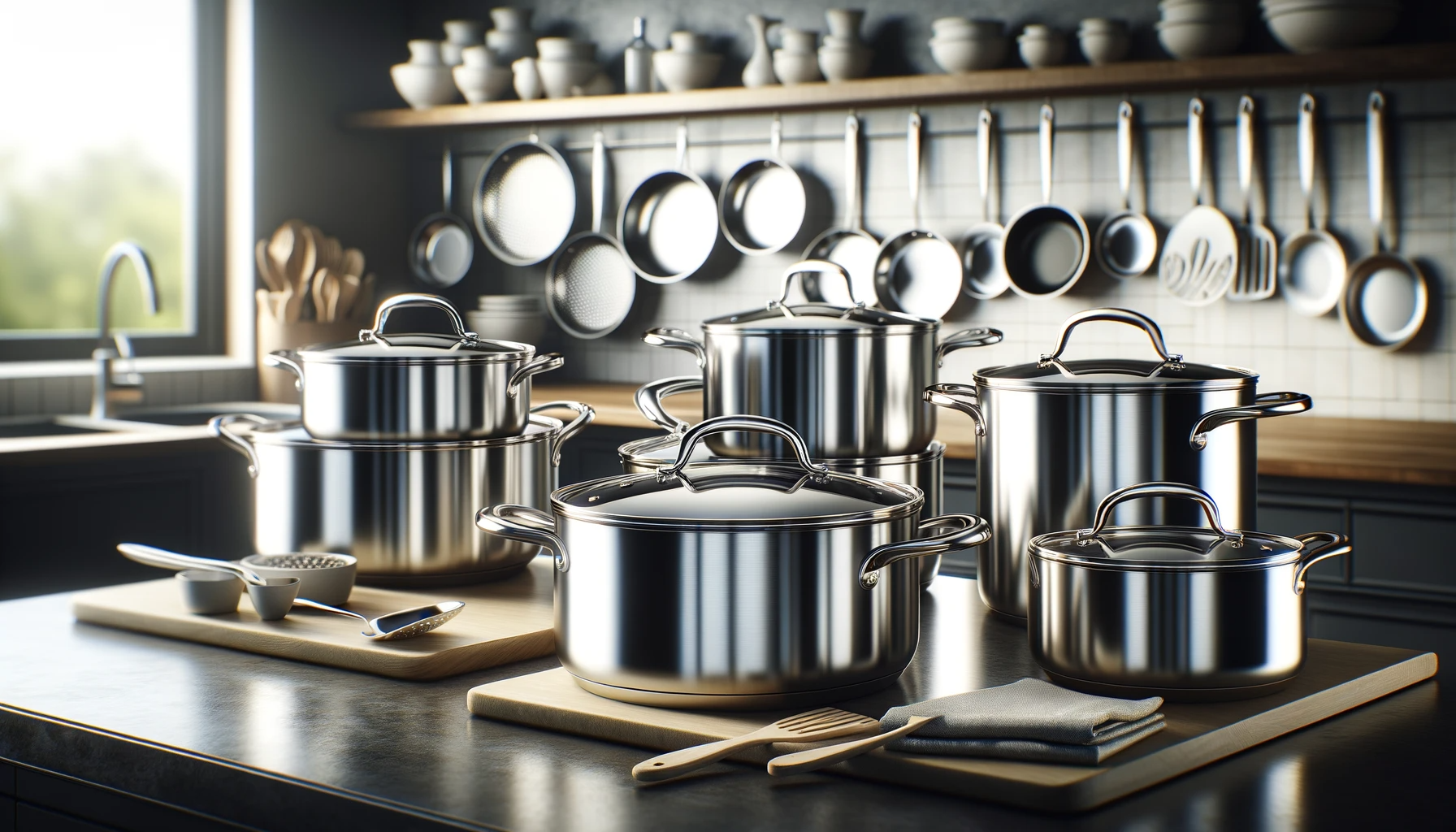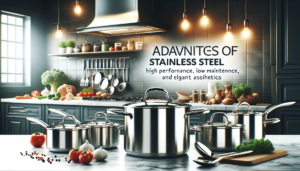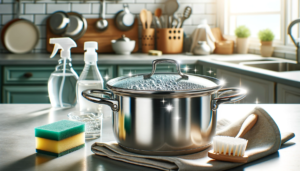With so many options on the cookware market, deciding between 3 ply vs 5 ply stainless steel can be a confusing decision.
How do you know which offers the best value and performance?
In this guide, we dive into the key differences between 3 ply and 5 ply stainless steel cookware construction to help inform buying decisions.
Let’s explore what sets these two excellent varieties apart and which excels for your cooking needs.
3 Ply Vs 5 Ply Stainless Steel Cookware
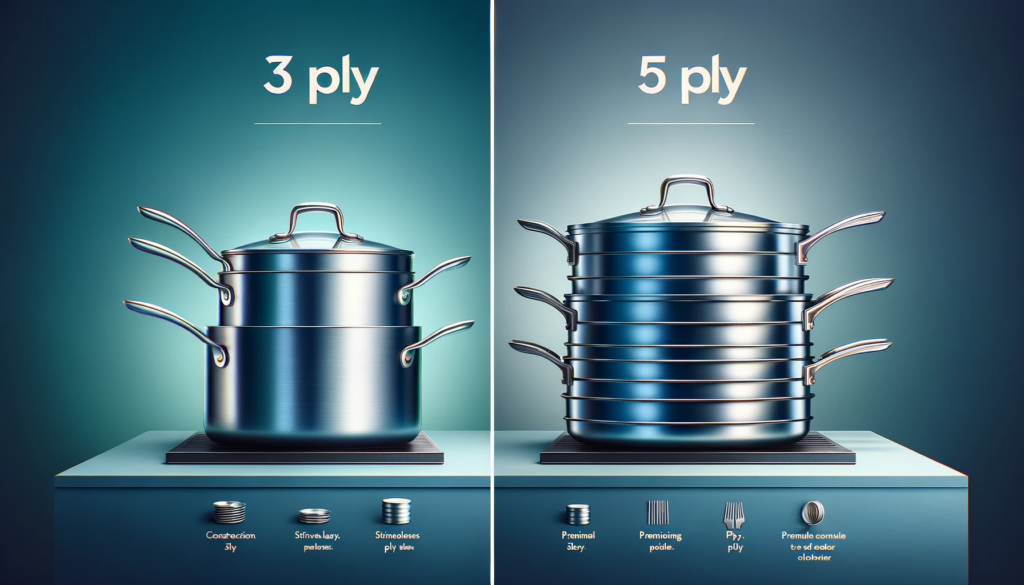
In short, 3 ply stainless steel cookware offers the best mix of value and versatility for most home kitchens.
It conducts heat fairly well, is reasonably durable for daily cooking, and comes at a budget friendly price point.
5 ply stainless steel cookware is a high end premium construction for more demanding cooks.
The extra layers make it extremely durable and evenly heating, at a substantially higher cost.
Below we dive deeper into explaining these competing varieties of layered stainless cookware to understand their key differences in performance, durability, and how that impacts pricing.
What Is Ply In Cookware

Ply refers to the number of layers of metal that are sandwiched together to make up the structure of a piece of cookware.
These multiple layers serve an important purpose when it comes to performance and durability of pots and pans.
The concept behind having more than one layer of metal in quality cooktop is to take advantage of the different properties that various metals have.
Some metals conduct heat well, others add strength and corrosion resistance, while another may be non reactive.
By strategically bonding different metals together into one body, manufacturers of high end stainless steel cookware aim to get the ideal combination of heating efficiency, evenness, and sturdiness.
The most common options for multi ply stainless steel on the consumer market today are 3 ply and 5 ply cookware.
In a 3 ply stainless steel pot or pan, there are usually 2 layers of durable stainless steel on the outside, with a heat conducting layer like aluminum or copper in the middle.
The stainless steel provides structure, ease of cleaning, corrosion resistance and allows for beautiful polishing to a mirror shine on the product exterior.
The interior core layer serves to improve heating responsiveness and conductivity across the bottom and up the sides of the pot or pan walls.
Copper in particular is prized for being an exceptional heat conductor, allowing rapid adjustment of temperature while cooking.
However copper by itself is too reactive with foods and requires maintenance to keep shiny, so it is sandwiched by and benefits from the stainless enclosure.
3 Ply Stainless Steel Cookware

In a typical 3 ply stainless steel construction, there will be a core middle layer of either aluminum or copper, with 2 exterior layers of stainless steel sandwiching the conductive layer.
This forms a strong, 3 layer bonded metal body.
Stainless steel alone conducts heat relatively poorly on its own.
However when it is combined with the aluminum or copper core in a 3 ply arrangement, the pot or pan performs substantially better by utilizing the heat responsive properties of those two metals.
There are a number of benefits associated with quality 3 ply stainless steel cookware.
First, it offers good functionality at a price point affordable to most home cooks.
Combining the ideal metals together compensates for the shortcomings an individual material may have.
Next, 3 ply stainless cookware tends to be lighter in weight than the heavier gauge 5 ply variety.
Lighter cookware is usually easier to maneuver and handle during cooking tasks.
A 3 ply pot or pan will heat up quickly thanks to that middle core layer helping conduct heat energy across the pan walls efficiently.
While perhaps not ideal for intense activities like heavily boiling liquids for a long time, or ultra high heat searing repeatedly, 3 ply stainless provides reliable versatility for most typical home cooking demands.
Of course there are some downsides associated with 3 ply stainless pots and pans to consider as well.
Over an extended period of heavy usage at high temperatures, some 3 ply products may start to warp from excessive heat exposure.
Though durable, the thinner 3 layers when compared to 5 ply also makes them incrementally less robust for extremely heavy duty commercial type preparation that requires equipment to endure exceptionally high heat and abrasion day in, day out.
Finally, affordable 3 ply cookware lines usually skimp on details like hand polishing, tending to apply cheaper machine finishing instead.
So expect a brushed look on most mid priced 3 ply selections as opposed to a true mirror finish shine.
5 Ply Stainless Steel Cookware
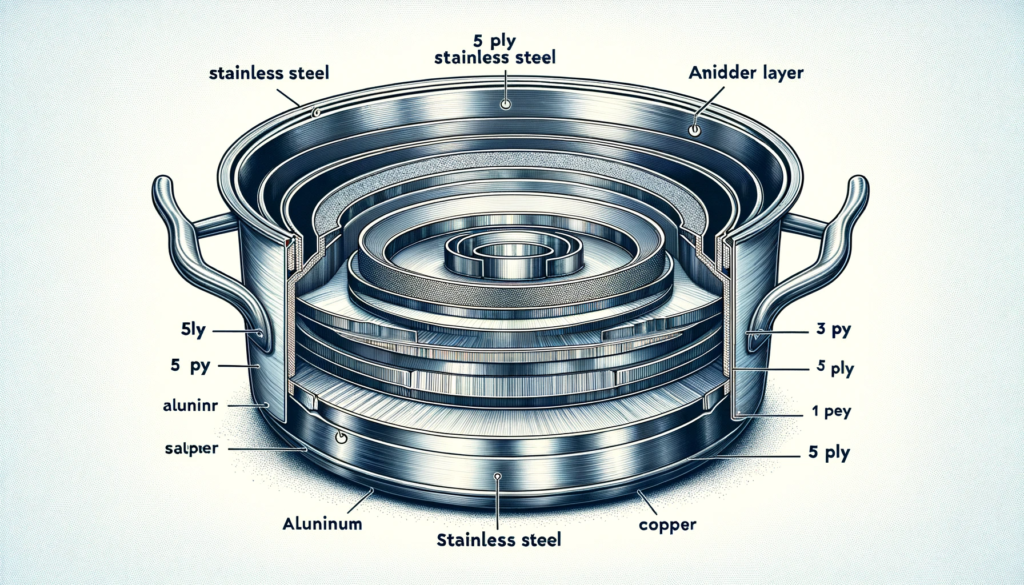
In a 5 ply stainless steel cookware construction, rather than just having a single conductive core layer sandwiched by 2 layers of stainless, there are additional sheets of stainless added both above and below that middle metal piece.
This results in a total of 5 bonded layers of metal forming an exceptionally rugged cookware body.
Usually that core heat conducting layer will still be either copper or aluminum in most cases.
But what sets 5 ply apart is the extra stainless steel, which adds noteworthy durability, heft, and resilience against warping even at demanding high heat levels used by serious home cooks and some professional kitchens.
So what are the main benefits of purchasing 5 ply cookware over the more affordable 3 ply alternative? For one, you can subject 5 ply pots and pans to much higher heat output, whether on the stovetop or under a broiler without damage over time.
That makes this variety well suited for tasks that need more intensity like getting the true sear on meat, maintaining a rolling boil for an extended period, or preparing food in the oven.
Thanks to those extra layers of stainless steel padding that core aluminum or copper center, heat distribution tends to be very even across the entire surface of 5 ply pans.
So no annoying hot spots here leading to food that sticks and burns on the cookware surface.
You can place 5 ply stainless on just about any stovetop source including induction which relies on ferrous metal near the surface to function optimally.
And it will likely outlast cheaper made options substantially when cared for properly due to robust, thick build.
Of course with greater performance and construction quality comes increased cost with 5 ply stainless steel.
It sits firmly in the premium segment of kitchen cookware, commanding a noticeably higher price at retail than entry level 3 ply and single layer stainless steel pots and pans mass produced overseas.
The layered build and polished finishing is labor intensive work as well in most cases.
All those extra sheets of metal add noticeable heft too.
While beloved by passionate home gourmets, some cooks may find 5 ply pans too heavy for comfort, especially larger stockpots.
And though durable, bonding points between layers can fail over many years of repetitive stress leading to product defects.
Fortunately most premium brands offer solid warranties should this happen.
Heat Distribution Comparison
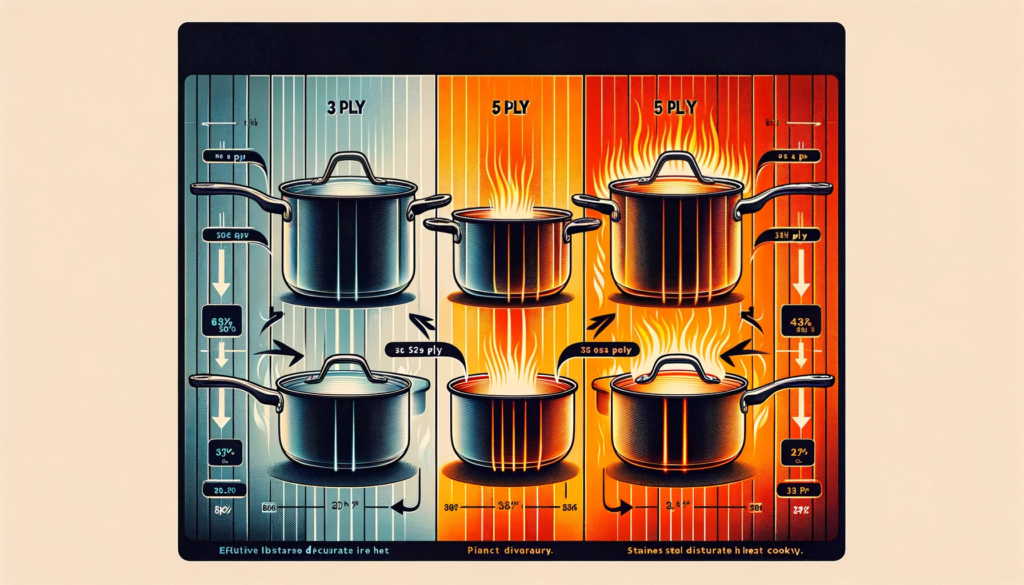
When considering kitchen workhorses like stockpots or large saucepans where evenly heating larger volumes of ingredients is key, 5 ply generally wins out noticeably over 3 ply thanks those extra sheets of stainless conducting and spreading heat energy thoroughly across the thick pan bottom and walls.
Food simply has a lower probability of singeing in 5 ply with no unexpected hot zones.
Searing meat to get that perfect crunchy, flavorful crust requires temperatures in excess of 500 F which many affordable 3 ply products may struggle with maintaining consistently across their thinner construction.
All in all, choosing 5 ply brings assurance that heat will be evenly spread leading to better controlled cooking.
However for tasks requiring more precision or responsiveness in temperature adjustment, some cooks still prefer quality 3 ply cookware over 5 ply.
Copper cores in particular require lower heat settings to get pans to appropriate temperatures thanks to incredibly efficient heat conductivity.
And aluminum core 3 ply still usually outpaces the majority of 5 ply at heat adjustment ability.
The thing is, do you really need your stockpot boiling instantly? For delicate simmering or tempering chocolate, rapid tweaking of the pan temperature is beneficial.
But for day to day cooking, 5 ply works beautifully once you adapt technique to its steady, even heating approach.
Price Differences

Good quality 3 ply stainless steel cookware occupies a nice sweet spot for budget conscious purchasers not wanting to compromise too much on performance.
Pieces can readily be had for under $100 giving flexibility to acquire an entire set of pots and pans useful for most home kitchens.
Even premium brands marketing sets specifically value priced for volume retail offer 3 ply construction for just a few hundred dollars.
Considering how long quality 3 ply lasts with proper maintenance, it proves a great return on dollars spent over many years of cooking enjoyment.
Once you move up to 5 ply products with better materials, hand finishing steps like hand polishing, premium branding, and construction warranties – prices rise noticeably higher despite similar dimensions on paper.
Because of the intricate labor involved creating sets, a 5 ply stockpot alone can run over $200 with whole sets ranging into four digits.
Of course individual pieces purchased selectively over time can lessen the initial cash outlay.
But there is no denying 5 ply ss cookware sits firmly in luxury territory given the exponentially higher costs over basic 3 ply and single layer products targeting value focused shoppers.
For cooks doing extensive meal preparation daily, the extra durability and longevity of 5 ply may justify costs long term.
Families and minimalist cooks not pushing pots and pans hard constantly can likely settle for more reasonably priced 3 ply without regret.
It all comes down to honest assessment of cooking routines.
Do you truly require advanced heat conductivity and ruggedness..
or does marketing have you convinced extra layers mysteriously improve food taste beyond the nominal? Price alone does not dictate performance, but accurately determining needs before purchase certainly saves money.
Top Brands For Each
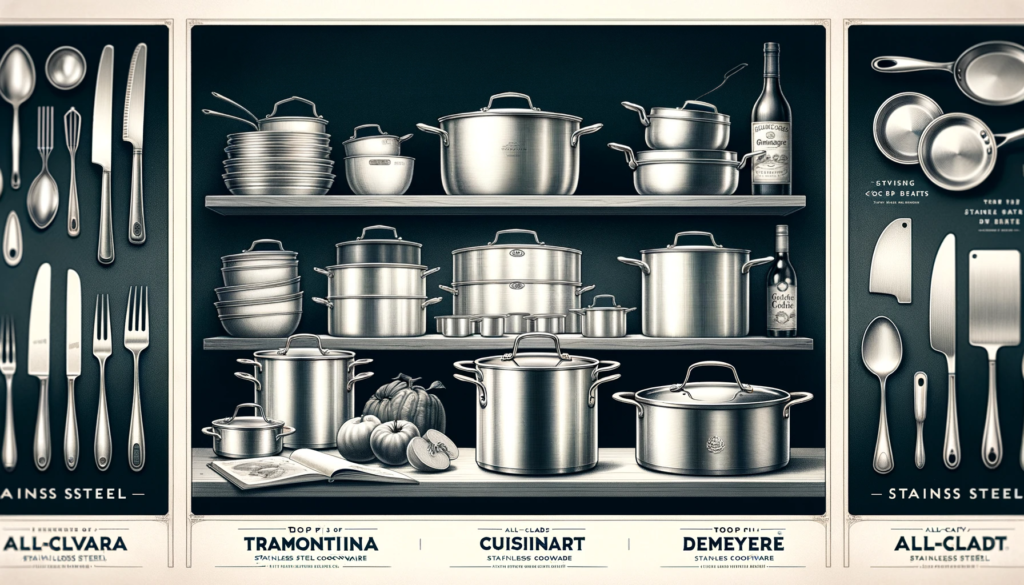
In the quality 3 ply stainless steel cookware arena, there are two brand names constantly rising to the top for offering excellent bang for the buck.
Tramontina and Cuisinart have built reputations through decades of reliable kitchenware products at reasonable prices.
Their 3 ply clad cookware lines adhere to that demonstrated value positioning while raising the bar on performance.
Home cooks laud their classic stainless steel aesthetic look backed by better responsiveness and heat distribution than cheaper disc bottomed options.
Though not at the pinnacle of fine cooking equipment, Tramontina and Cuisinart 3 ply sets merit their popularity across various online and big box retailers.
When it comes to premium 5 ply stainless steel cookware coveted by serious home gourmet cooks, two brands stand atop the simmering pot.
Both All-Clad and Demeyere build their 5 ply lines in Pennsylvania and Belgium respectively through specialized processes bringing together the highest grade metals to withstand punishing daily use on all heat sources.
While priced substantially above basic stainless steel or 3 ply pots and pans, All-Clad and Demeyere collections have built cult followings based on their impeccable cooking ability.
From Demeyere’s 7 layer Atlantis frypan to All Clad’s copper core series, exceptional even heating and highly responsive temperature control explain their praise among discerning cookware critics and demanding restaurant chefs.
Though costly, their impressive performance validates the adulation.
Conclusion
While more affordable, quality 3 ply stainless steel cookware excels for most daily home cooking tasks.
The combination of a conductive core like aluminum or copper wrapped by durable stainless steel into a 3 layer bonded body brings good versatility.
5 ply stainless steel pans utilize extra interior sheets of stainless to sandwich the aluminum or copper core, creating an exceptionally sturdy 5 layer thick cookware construction.
This brings higher performance under stress and more even heating demanded by cooking enthusiasts.
However that rugged build and intricate hand finishing does raise prices on 5 ply pots substantially.
Evaluate your current cooking style and demands in the kitchen honestly before deciding between these two excellent stainless steel options.
